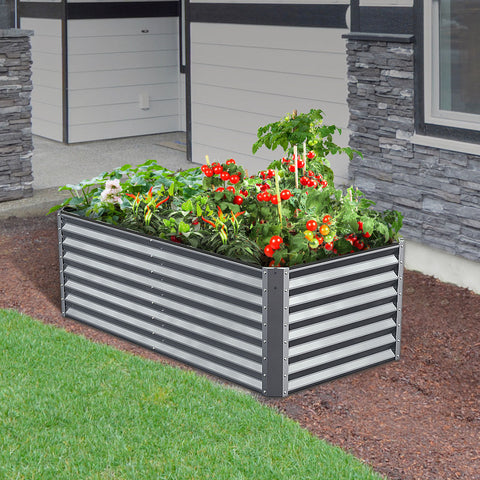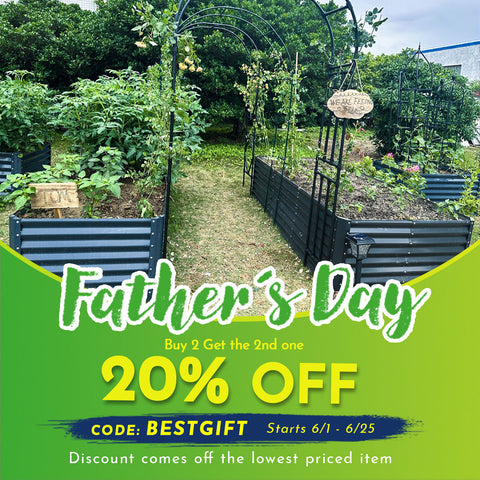What are the best fruits and vegetables you can grow?
Finding the best fruits and vegetables to grow is not as easy as I thought. Some require careful care, some are susceptible to pests, and many are simply not simple and fast enough to grow.The following content also has some reference value for raised garden beds.

That's why I've put together a list of the 10 best fruits and vegetables you can grow!
This ultimate guide will tell you the best fruits and vegetables to grow, why you should grow them, and even how to grow them.
Read this article before growing fruits and vegetables
Knowing the hardiness zone you are in is crucial to knowing the best fruits and vegetables that can be grown.
It can be the difference between your fruits and vegetables thriving, providing abundant yield or not producing, and possibly even dying.
If you want to know which cold-resistant zone you live in, take a look at the map below:
10 best fruits and vegetables
# 1. Apple tree
Popular varieties: Gold Crown, Red Crown, Grandma
Why plant apple trees?
Cold Hardy:
- Apple trees thrive in cold spring and cool fall. Unlike other fruits, flowers and fruits can grow even in late spring when there is snow or frost.
Easy to grow:
- Apple trees are probably the easiest fruit to grow. You don't need to fertilize, you don't need to water, you can plant in any soil, and you need little to no pruning, if any.
Works with any property:
- Apple trees are perfect for any gardener's yard, which means it's perfect for small or large gardens.
Heavy harvest:
- Of all the fruit trees on this list, apple trees are one of the most harvested. From late August to November, you can pick more apples than you can eat.
These will hurt your apple trees
Pest:
- Deer, rabbits and squirrels like apple trees. If left unprotected, these pests will eat your fruit before it has fully grown.
Insects:
- Of all the fruit trees on this list, insects are the most likely to attack apple trees. Whether it's Japanese beetles or aphids, you must constantly spray and care for your apple tree to prevent insect infestations
Illness:
- Again, of all the fruit trees on this list, apple trees are the most susceptible to disease. Blight and mold are just two of the diseases that can attack, harm and sometimes kill your fruit trees in the spring or summer.
Additional resources
Learn how to plant apple trees here

# 2. lettuce
Popular varieties :Butterhead, Boston, Loose Leaf
Why do you grow lettuce?
Cold Hardy:
- Lettuce thrives in cold spring and cool fall. Unlike other vegetables, this plant can grow even when there is snow or frost on the ground.
Low:
Lettuce is probably the easiest vegetable to grow. You don't need fertilizer, just water it once a week, and it can be planted in any soil.
Annual harvest:
- Lettuce can be harvested all year round. The more lettuce you harvest, the more it will grow.
These will hurt your lettuce
vermin
- Deer, rabbits and squirrels all like lettuce. If left unprotected, these pests will eat your vegetables before they can grow.
Extremely hot
- Although rare, this can cause lettuce to bloom and become inedible. Make sure your lettuce is grown in partial shade to avoid this.
Additional resources
Learn how to grow lettuce here
# 3. kale
Popular varieties: Curly, pulled, Russian red, decorative
Why grow kale?
Cold Hardy:
- Kale is the hardiest vegetable. Unlike other vegetables on this list, kale can be grown all year round.
Decoration:
- Kale is the only vegetable on this list that can be considered an ornamental plant. This means it can add colour, character and beauty to any type of garden.
Suitable for pot:
- If there's one vegetable that can be grown in a pot, it's kale. This is one of the most adaptable vegetables and is perfect for beginners.
These will hurt your kale
Aphids:
- Like many other vegetables, aphids are an insect you don't want. Aphids are especially prevalent and can hinder or kill your kale.
- Like lettuce, kale does not tolerate extreme heat. In temperatures above 90 degrees Fahrenheit and direct sunlight, kale blooms and becomes inedible after a week.
Additional resources
Learn how to grow kale here

# 4. blueberry
Popular varieties: Blue Jay, Blue Crop, Duke, Pink Icing
Why grow blueberries?
Cold Hardy:
- Blueberry bushes thrive in cold spring and cool fall. Unlike other fruits, flowers and berries can grow even in late spring when there is snow or frost.
Rapid growth:
- Blueberries are probably one of the fastest growing berry bushes. With just a little peat moss and fertilizer, you can expect your bush to grow 6 feet tall in just a few years and produce more berries than you know what to do with.
These will hurt your blueberries
Insects:
Blueberry bushes are prone to disease. Mold and root rot are just two of the diseases that can harm, attack, and kill blueberry bushes during winter and spring.
Additional resources
Learn how to grow blueberries here
Popular varieties: Chicago, Turkey, Brown
# 5 Figs
Why plant figs?
Pest resistance:
- The FIG tree is the only truly pest-resistant fruit tree on this list. Deer hate FIG trees, rabbits can't reach the fruit, and squirrels and chipmunks find easier food elsewhere.
Suitable for indoor and outdoor:
- None of the other fruits on this list can be grown indoors or outdoors. FIG trees can thrive outdoors, but most gardeners will plant them in POTS, leave them outside during the summer months, and bring them indoors after the first frost of the year.
Easy to grow:
- Once you've planted the figs in a pot, you don't need to do anything else. You don't have to worry about insects or disease, just water once a week, and you don't even have to worry about pruning FIG growth.
These will hurt your figs
Cold:
While some types of FIG trees can survive the winter and grow well, most will be stunted, do not bear fruit, and may even die.
Drought:
- If you put a FIG tree in a pot, drought will hinder and kill your tree. This is because FIG trees dry faster in POTS than in the ground.
Additional resources
Learn how to prune a FIG tree here.
# 6. Tomato
Common varieties: cherry, steak, brandy
Why do you grow tomatoes?
Grow in heat;
- As the summer warms, tomatoes continue to get bigger and more abundant. No more searching for low-maintenance vegetables.
Suitable for vertical gardening:
- Tomatoes are considered vine vegetables. Because of this, you can train them to grow vertically, which is perfect for gardeners with very little space.
Suitable for small Spaces:
- Tomatoes are great for small Spaces, which means they fit well in POTS. Just plant them in a small pot and enjoy them in your city and suburban houses.
These will damage your tomatoes
Insects:
- Tomatoes are one of the most vulnerable vegetables to insects. Aphids, fruit flies, and even bed bugs love to eat them. If you wait too long to harvest, these insects can become a problem.
Illness:
Tomatoes are also one of the most susceptible vegetables to disease, especially heirloom varieties. Expect blight, fungus, and buckeye rot to affect your plants during the late summer months (even if you care for them properly).
Additional resources
Learn how to grow tomatoes here.
Popular breeds: Royal Monarch, Albion, Rossi

#7. Strawberries
Why grow strawberries?
Grow in heat;
Ideal for vertical gardening and garden POTS:
Rapid growth:
These will damage your strawberries
Cold:
Strawberries don't bear the cold. While some varieties can survive cold weather, most will die if winter temperatures consistently drop below 10 degrees Fahrenheit. In winter, you should spread hay, leaves, or burlap over it.
Illness:
Additional resources
When planting strawberries, you should protect them with a fence or bird net to protect the flowers and berries from birds, chipmunks, and squirrels.
# 8. Pepper
Popular varieties: Bell, Jalapeno, Habanero
Why plant peppers?
Love Heat:
- These maintenance-free vegetables love high temperatures. The hotter the summer, the better they do. The longer summer lasts, the more hot peppers there will be.
Vertical garden:
- Peppers are one vegetable you might not think of when it comes to vertical gardening, but they're just as good as any. This makes it perfect for small Spaces, even in flowerpots.
These will hurt your peppers
Cold:
- Chili plants, like most of the plants on this list, cannot tolerate cold weather. If the temperature drops below 50 degrees Fahrenheit, your tree will not grow or produce peppers. If the temperature drops below freezing, your peppers will die.
Illness:
- Peppers tend to get sick in late summer. Expect blight, fungus and rot to affect your plants later in the season when you harvest your peppers.
Additional resources
Learn how to grow peppers here
Popular varieties: Squash, spaghetti squash, zucchini

# 9. Pumpkins
Why do you grow pumpkins?
Thrive in drought:
Unlike other vegetables, pumpkins don't need a lot of water to grow, flower, bloom, and become a crop that can be harvested multiple times. That's great for an unusually dry summer.
Suitable for vertical gardening:
- If you want a vegetable that grows on a pole, look for pumpkins. Pumpkins can be grown horizontally, but vertical growth is also good.
These will hurt your pumpkin
Pest:
- Pumpkin is another vegetable that is not good for pests. Deer, rabbits, and other animals can eat flowers, leaves, and even plant stems.
Additional resources









